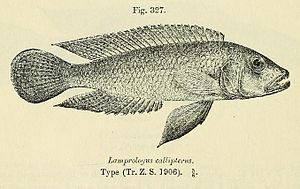Lamprologus callipterus
| Lamprologus callipterus | ||||||||||||
|---|---|---|---|---|---|---|---|---|---|---|---|---|

Drawing of the holotype of Lamprologus callipterus from the first description, a male from the Congolese shore of Lake Tanganyika. |
||||||||||||
| Systematics | ||||||||||||
|
||||||||||||
| Scientific name | ||||||||||||
| Lamprologus callipterus | ||||||||||||
| Boulenger , 1906 |
Lamprologus callipterus is in the East African Lake Tanganyika endemic occurring cichlid .
description
The fish are elongated and the trunk is more than three times as long as the head. They are gray-yellowish to olive-yellow in color. The fins are gray, large parts of the dorsal fin and the caudal fin are patterned with dots. The dorsal fin and the upper edge of the caudal fin are lined with dark. The most striking feature of Lamprologus callipterus is the extreme sexual dimorphism in terms of size. Males can reach a length of 15 to 16 cm, while the females only grow to 4.5 to 6.5 cm. In addition to the normal-sized males, there are also dwarf males that only reach the size of the females.
- Scale formula 35-37 (SL)
Way of life
Lamprologus callipterus is widespread throughout the lake and lives there in the transition area between rock, scree and sand. The fish are voracious and feed mainly on small crustaceans. The large males form large swarms outside of their reproductive time, which lasts on average 33 days, which roam around together and swim very quickly in search of food. They chew through the sand or look for small animals in the growth of the rocks. The clutches of other, substrate-spawning cichlids are also looted, even those of the 65 to 70 cm long Boulengerochromis microlepis , the largest species of cichlid in Lake Tanganyika.
In order to reproduce, the large males, which form territory and harem, dig shallow pits in the sandy soil into which they bring numerous (up to 200) empty snail shells (genus Neothauma ), which the females use as a breeding cave. The females lay their eggs on the inside of the snail shell; the males inseminate the clutch from the outside because they are too big for the snail shell. Since they are not recognized as males by the larger males, the dwarf males can invade the spawning pit of the larger competitor without being noticed and also inseminate eggs deposited there. It takes about 10 to 14 days from the egg-laying until the young fish swim free. During this time, eggs, larvae and fry are looked after by the female. In the large accumulations of snail shells now and then it also breeds the shell dwellers Neolamprologus multifasciatus , a relative in which the females and all males are dwarfed.
Systematics
Lamprologus callipterus was first described scientifically in 1906 by the Belgian-British ichthyologist George Albert Boulenger . The holotype is a male that was caught on the Congolese shores of Lake Tanganyika in what was then the Belgian Congo colony . In the same publication, Boulenger described a smaller cichlid and named it Lamprologus reticulatus . It was not until 1946 that the Belgian ichthyologist Max Poll found out that the smaller cichlid was the female of Lamprologus callipterus . Lamprologus reticulatus then became a synonym for L. callipterus .
Lamprologus callipterus is not very close with Lamprologus congoensis , of living in the lower Congo type species of the genus Lamprologus used, but forms with the lamprologus ocellatus ( Lamprologus ocellatus ), Neolamprologus fasciatus and the species of the genus Altolamprologus a monophyletic clade within the tribe Lamprologini .
Individual evidence
- ↑ a b c d Pierre Brichard: The Great Book of Tanganyika Cichlids. With all the other fish on Lake Tanganyika. Bede Verlag, 1995, ISBN 978-3927997943 , pages 331-333 u. 372.
- ^ Soren Neergaard: Tanganyika - Cichlids. Kernen Verlag, 1982, ISBN 3-8740-1005-8 , page 81.
- ↑ a b c Horst Linke, Wolfgang Staek: African Cichlids II, cichlids from East Africa. Tetra-Verlag, Bissendorf 1997, ISBN 3-8935-6152-8 , pages 95-96.
- ↑ a b Dolores Schütz, Gudrun Pachler, Erwin Ripmeester, Olivier Goffinet and Michael Taborsky (2010): Reproductive investment of giants and dwarfs: specialized tactics in a cichlid fish with alternative male morphs . Functional Ecology 2009, 24 (1): 131-140 doi: 10.1111 / j.1365-2435.2009.01605.x
- ↑ Lamprologus callipterus on Fishbase.org (English)
- ↑ George Albert Boulenger (1906): Fourth contribution to the ichthyology of Lake Tanganyika. Report on the collection of fishes made by Dr. WA Cunnington during the Third Tanganyika Expedition, 1904-1905. Transactions of the Zoological Society of London. Volume 17
- ↑ Christian Sturmbauer, Walter Salzburger, Nina Duftner, Robert Schelly, Stephan Koblmüller: Evolutionary history of the Lake Tanganyika cichlid tribe Lamprologini (Teleostei: Perciformes) derived from mitochondrial and nuclear DNA data. Molecular Phylogenetics and Evolution 57 (2010) 266-284, doi: 10.1016 / j.ympev.2010.06.018
